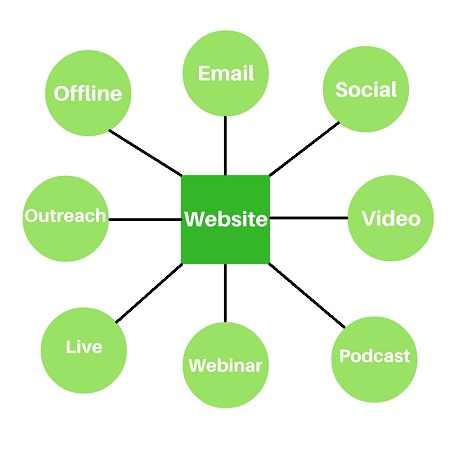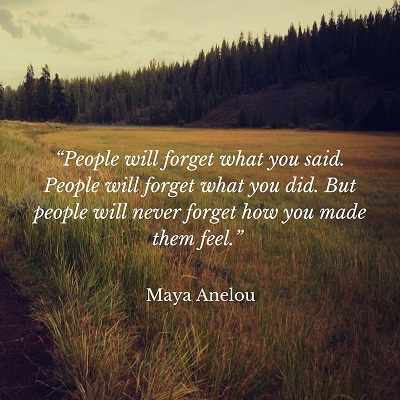Why your central hub shouldn’t be your only presence online.
At One Web Street we write & talk a lot about your business website being the central hub of your online presence, and I’m not here to say that is wrong. Rather, that it is the central part, but there is so much more than that.
Your business website is the hub of your business, but there should be numerous spokes reaching out to people who will then visit your website and interact with you (or take action of some sort).
If we were here just 5 years ago then it wouldn’t really be the case and there might be somethings that you possibly wouldn’t consider.
Yes, Facebook was around then (as well as Twitter and YouTube), but wide use of video and advertising on Facebook wouldn’t be here, not as prominently as it is now for your business anyway. That’s how quickly things change.

Leadpages, Clickfunnels and Thrive landers all came about from the upsurge of businesses using Facebook ads and the ease of targeting on their platform. There was a clear need earlier for landing pages because of AdWords, but because lots of smaller companies weren’t really using the platform (not to the extent that they use Facebook) there wasn’t that many options to fill the gap in the market.
So, what does this all mean? Well, businesses have had to connect on a more unique level with prospective customers/clients: the internet and individuals searching for solutions to their problems can no longer be referred to as a ‘fad’ anymore.
There is real engagement and money to be made by businesses in many different sectors and niches; it doesn’t matter what you sell at the moment there is always someone out there who wants to buy it. You just need to find out where they are and position yourself in the right way.
Even in the last 18 months Facebook has changed quite a lot of things.
- Pages don’t get as much organic reach as they once did
- More businesses are advertising
- Groups have become communities to belong to
- Facebook introduced its own lead optin service to keep people in the FB environment
- Live video
- Increased use of video in ads
Why does Facebook deserve a specific mention here? Because Facebook should be a platform used in every business’s online presence strategy. And yes, your target audience is on Facebook (there are billions of people worldwide using it), and their advertising platform allows you to reach them and target quite specifically.
This might change over the next few months/years, but Facebook has made it more accessible for smaller businesses to uniquely target potential clients and interact with them: the main stage is how these businesses then choose to do the interacting & enticing on whether there is success or not.
Social Media
By now you probably know that social media is important, but do you know which channels are having the most effective impact on the growth of your brand?
If not, it’s worth taking time out now to think about things. Choose two or three channels where you think your audience will be, where you can interact with them, offer them free advice and then offer them the opportunity to work with you (or buy from you).
Some of the places people are quite active are: Facebook, Instagram, YouTube, Snapchat, Twitter (lots of spam & ‘noise’ though), Linkedin (B2B),
Video & Podcasts
A huge medium that helps businesses connect with potential clients. There is something in human instinct that connects a person to your voice (or even your voice & face). A lot of it is linked to tonality and a person actually being able to picture you in their mind. As you’re reading this – if you haven’t already heard my dashing northern British accent – then you might be thinking what I sound like, what I’m emphasizing most in what I’m writing about and how I feel about it.
These are all subtle cues to the human ear (and eyes if you’re on video) about whether we will want to trust a person behind the brand and whether we will want to buy from them (or buy what they recommend).
Where Should You Be Online?
That’s the key question here, isn’t it? There are so many different choices, but what’s the key answer? Wherever the majority of your potential clients are.
For sure that is Facebook, but they’re probably on other platforms too. If you’re selling B2B then Linkedin is a must, and Twitter as a secondary. If you’re selling B2C then Facebook & Instagram are prominent with YouTube & Snapchat being good mediums for video content and connection.
But this only includes the first steps and pulls from a predominantly Western/English speaking perspective. If your market is predominantly in Asia then it’s worth giving things a little more thought.
The Future Online
There’s a lot that’s changed over the past 18 months and there’s going to be some massive changes over the next 18. What will that involve? Well, the sky is the limit, but it does look like live video, engagement with the audience (rapid) and interacting in a community are all what will continue into the rest of this year and dominate the next.
This gives you the opportunity. You’re not a large organization with 1000s of employees (if you are you really shouldn’t be reading this), so you’ve got the ability to change direction, start new things and really move into an area of dominating your niche/sector or area of online space that you excel in.
So, to finish this off I’ll leave you with a quote from Maya Angelou. It had a real impact with me when I first heard it because it’s so true!
